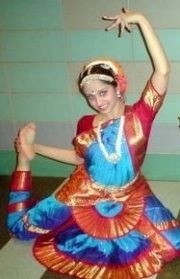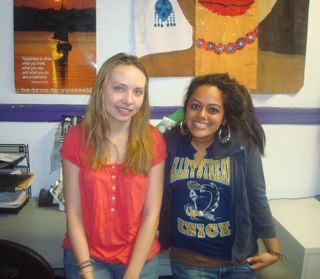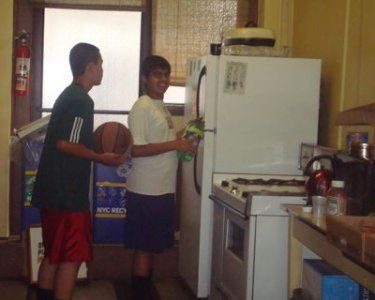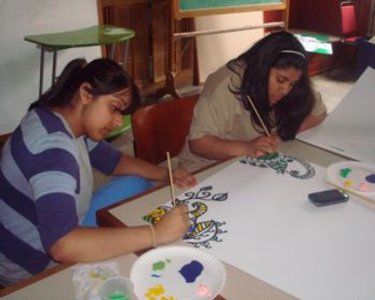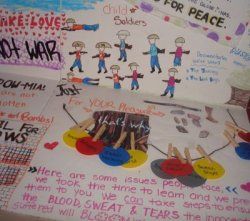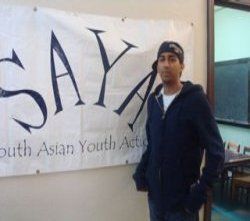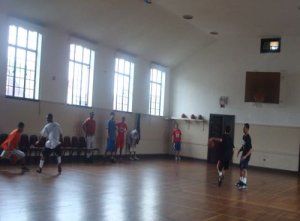From The Peopling of New York City
"An newly emerging youth culture is always part of any diaspora. After all, these immigrant children must make a place for themselves in the new society."(Interview with Sasha Neha Ahuja)
Many of the South Asian immigrants who arrived in New York City during the 1980/90s, are now an established part of the city. The second generation of these immigrants, however, is now starting to come of age, enter college, and join the workforce.(The term "second generation" refers to children of immigrants who were born in the United States or arrived at a young age.) These youth have collectively created a new popular culture based on dance parties, music mixes, Bollywood movies, and Desi pride. This emerging Indian-American identity is unique because it fuses the traditional customs and beliefs of Indian convention, with distinctly opposing American values. This creates a hybridized culture caught in between two worlds, that is important to understand. According to Sunaina Marr Maira, author of "Desis in the House: Indian American Youth Culture in New York City,"A focus on second-generation Indian Americans is crucial to understanding how Indian Americans and other new immigrant communities will be inserted into the economic and social fabric of the nation-state."
Indian- American youth tend to associate with fellow Desis for reasons that surpass a common ethnicity. It's the shared interest and knowledge of Indian music, film, and dance culture, that creates a uniting and socializing force for young Indian- Americans. The creation of ethnically centered clubs, organizations, and events reflects this.
After interviewing Samantha Shetty, a long-time member of Hunter College's Desi Club, it was clear that music and dance tied Samantha and her peers together. Although Samantha does not reside in Jackson Heights, she is invariably connected with the music, dance, and film scene that is present there. The creation of a college club that is ethnically centered, mirrors the creation of Jackson Heights, an ethnically centered community. It seems the reason South Asians feel comfortable in such establishments, is the sense of familiarity they exude. Shoppers in Jackson Heights are able to interact with friends familiar with South Asian produce, while members of the Desi Club can chat about the latest Bollywood release. Samantha reaffirms this sense of commonality when she says, "I guess I feel comfortable in the Desi Club 'cause its become a little community. We all share a similar background, deal with the same issues at home, listen to similar music, and because of that, really enjoy eachother's company.
Similar to Samantha, Nikhal Ranu, a Queens resident and high school senior, admits that his friends are predominantly Indian. In his own words, "that is because I cold speak to them in my own tongues. It just makes things more confortabls. We share the same background, the same morals, its easier to understand what's going on in a fellow Desi's life".
South Asian Youth Action (SAYA) South Asian Youth Action Website is a one-of-a kind youth development center in Elmhurst, Queens that targets low-income immigrant families of Queens. Visiting the site, and speaking to Sasha Neha Ahuja,the coordinator of SAYA's Academics Program, it is evident that this 12 year old initiative provides an effective way to empower immigrant children. In Sasha's opinion, "there's a lack of space for immigrant children to be young and even have their experiences validated. That doesn't usually happen in schools. These youth aren't taught school curriculum telling them where they came from."
In addition to encouraging ethnic exploration, SAYA offers Academic programs, such as tutoring and SAT, college, and career prep. There is also a youth leadership branch of SAYA, which comprises of a co-ed educational group, ARISE, and a young woman leadership group called "Desi Girls on 'da Rise."
As expected, there are music and dance programs at SAYA. "Music is a very visible part of South Asian culture", and we encourage our youth to explore that aspect. A lot of our students do Bhangra and are DJs", Sasha says. One such DJ, Nikhal Ranu, is also an intern at SAYA. "Music is a connection between all barriers", he says, " I was at this street fair in Jackson Heights, and there were Indian, white, black, and hispanic people..all dancing. Even though they dont know what to do, they put their hands up in the air and dance. There's something about Bhangra music that simply makes you want to dance like crazy."
In addition to encouraging ethnic exploration, SAYA offers Academic programs, such as tutoring and SAT, college, and career prep. There is also a youth leadership branch of SAYA, which comprises of a co-ed educational group, ARISE, and a young woman leadership group called "Desi Girls on 'da Rise."
As expected, there are music and dance programs at SAYA. "Music is a very visible part of South Asian culture", and we encourage our youth to explore that aspect. A lot of our students do Bhangra and are DJs", Sasha says. One such DJ, Nikhal Ranu, is also an intern at SAYA. "Music is a connection between all barriers", he says, " I was at this street fair in Jackson Heights, and there were Indian, white, black, and hispanic people..all dancing. Even though they dont know what to do, they put their hands up in the air and dance. There's something about Bhangra music that simply makes you want to dance like crazy."
What is Bhangra?
Bhangra is a form of music and dance that originated in the Punjab region of primarily Pakistan and India. It is become popularized by the Indian Sikh Community. While Bhangra began as a folk dance conducted by farmers to celebrate the coming of Spring, today bhangra exists in different forms and styles all over the globe. "When it comes to celebrating my culture, I cant think of a better way than a Bhangra dance party" (Interview with Nikhal Ranu).
Music: A Badge of Indian American Identity
Studying Indian-American youth, it is impossible to avoid the ubiquitous influence of Indian music and dance. It is at the crux of Indian-American youth identity and pride. "There are plenty of songs that send the message of South Asians being the best" (Nikhal Ranu). This amplification of national pride contributes to the fervor with which young Indian-Americans follow the Bhangra remix, hip-hop fusion scene. When asked about the Desi Club's annual formal, Samantha Shetty explains,"the formal is all about about pride. Its a celebration of our ethnicity through cultural music. We have Punjabi, Bollywood, and fusion dances."
The Hybridization of Music: Bhangra Remix & Fusion
A visibly unique element of Indian American popular culture is Bhangra remixing, or hip-hop/rap fusion. This is when Indian folk or film music, is mixed with American dance or hip-hop music, and produced by Indian American DJs to be played at 'Desi parties'. Expert Sunauna Marr Maira feels that this ethnically exclusive space, "reflects the social networks and college cliques among youth who participate in this "desi scene," and who believe that those who are identified as "truly" South Asian are those who fraternize only with other South Asians (Maira 2002:12).
But despite this exclusion in the party scene, popular Indian- American music is continually becoming increasingly fused with various genres. “Fusion music is definitely growing”, says Nik, I think it got so popular because of Jay Z’s collaboration with the British Indian Musician, Punjabi MC. Their song “Beware of the Boys” became a hit worldwide. The success of this track, and others like it, is proof of the impact American musical trends have made on the Indian music industry.
Traditional Indian song topics are fading away, as topics including liquor, drugs, and ascension in rank are being emphasized. “Some of the latest popular Indian music videos look exactly like those I see on MTV. Take Jazzy B, for example, he doesn’t hold it back, and all my friends love him:, Nikhal says. Jazzy B’s success in Bhangra can be attributed to his willingness to fuse elements of hip-hop and rap. The music video for his single “Soorma” , for example, is based on actors playing drug dealers who drive Hummer H2s and carry machine guns. With the success of artists such as Jazzy B, the Bhangra fusion genre is steadily developing today.
Music plays a defining role in Indian- American youth identity. It serves as a socializing force, a common tie, between second-generation youth. In order to construct this musically centered identity, consumption is required, and Jackson Heights has remained New York's top destination for Indian tunes. In this way, Jackson Heights,a microcosm of South Asian immigrant life today, plays a continual part in the development of Indian- American youth culture.
Visual Examples of Youth Culture Trends in the Media

